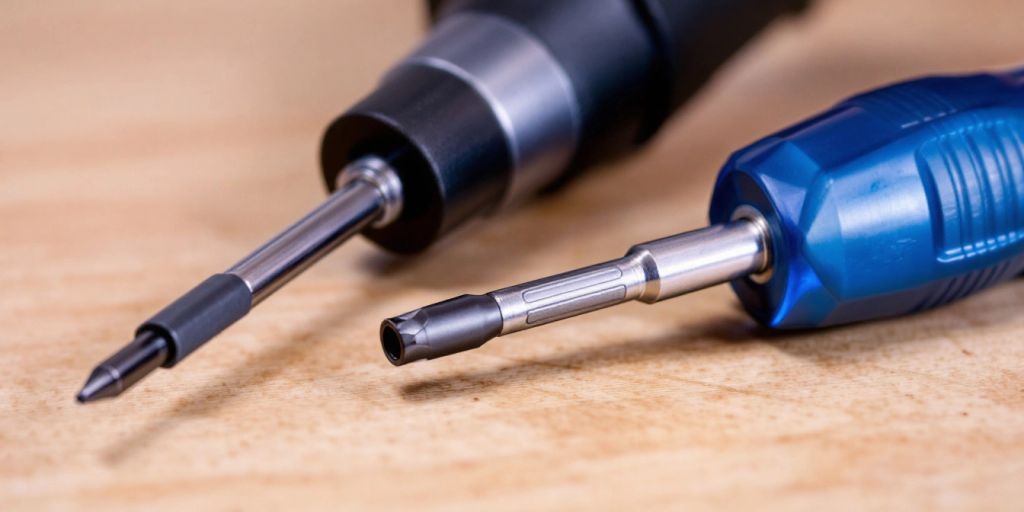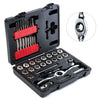
Electric vs. Manual Screwdrivers for Computer Repair
When it comes to repairing computers, choosing the right screwdriver can make a big difference. Electric and manual screwdrivers each have their own benefits and drawbacks. Understanding these can help you pick the best tool for your needs. In this article, we will explore the pros and cons of both types of screwdrivers and offer tips on how to choose the right one for your computer repair tool kit.
Key Takeaways
-
Electric screwdrivers are faster and easier to use, which can save time during repairs.
-
Manual screwdrivers allow for greater control, reducing the risk of damaging screws.
-
Electric screwdrivers can be more expensive and may require charging.
-
Manual screwdrivers are more affordable and often last longer with proper care.
-
Choosing the right screwdriver depends on your specific repair needs and comfort.
Advantages of Electric Screwdrivers in Computer Repair Tool Kits
Electric screwdrivers have become essential tools in computer repair due to their numerous advantages. Here are some key benefits:
Enhanced Efficiency and Speed
Electric screwdrivers can significantly speed up the repair process. They allow for quick fastening and unfastening of screws, which is especially useful when dealing with multiple screws in tight spaces. This efficiency can save valuable time during repairs.
Reduced Physical Strain
Using an electric screwdriver minimizes the physical effort required to turn screws. This is particularly beneficial for technicians who perform repetitive tasks, as it helps to reduce fatigue and strain on the hands and wrists.
Versatility with Interchangeable Bits
Many electric screwdrivers come with a variety of interchangeable bits, making them suitable for different types of screws. This versatility means that one tool can handle various tasks, reducing the need to carry multiple screwdrivers.
Electric screwdrivers are not just about speed; they also enhance precision when used correctly.
|
Feature |
Electric Screwdrivers |
Manual Screwdrivers |
|---|---|---|
|
Speed |
High |
Moderate |
|
Physical Strain |
Low |
High |
|
Versatility |
High |
Moderate |
|
Control |
Moderate |
High |
In summary, electric screwdrivers offer a blend of speed, reduced strain, and versatility, making them a valuable addition to any computer repair toolkit. Their ability to handle various tasks efficiently can greatly enhance the repair experience.
Drawbacks of Using Electric Screwdrivers for Computer Repairs

Risk of Over-Tightening and Stripping Screws
One of the main concerns with electric screwdrivers is the risk of over-tightening screws. This can lead to stripped screws, which can make future repairs difficult. When using an electric screwdriver, it’s easy to apply too much force, especially if you’re not careful. This is particularly problematic in delicate computer components where precision is key.
Battery Life and Charging Concerns
Another drawback is the battery life of electric screwdrivers. If the battery runs out during a repair, it can interrupt your workflow. Additionally, frequent charging can be a hassle, especially if you’re in the middle of a project.
Higher Initial Investment
Electric screwdrivers often come with a higher initial cost compared to manual options. While they can save time, the upfront expense may not be justifiable for everyone, especially for casual users.
In many cases, investing in a quality manual screwdriver can provide better control and precision, making it a more reliable choice for computer repairs.
Overall, while electric screwdrivers offer convenience, these drawbacks should be carefully considered before adding them to your toolkit.
Related Article: Portable Computer Repair Kits: Pros and Cons
Benefits of Manual Screwdrivers in Computer Repair Tool Kits

Greater Control and Precision
Manual screwdrivers offer greater control when working on delicate components. This is especially important in computer repair, where precision is key. With a manual screwdriver, you can feel the resistance of the screw, allowing you to adjust your pressure accordingly. This helps prevent damage to sensitive parts.
Lower Risk of Damage
Using manual screwdrivers reduces the risk of damaging screws or components. Electric screwdrivers can easily strip screws if too much force is applied. In contrast, manual screwdrivers allow for a more careful approach, ensuring that screws are tightened just right without overdoing it.
In summary, manual screwdrivers provide essential benefits for computer repair, including better control, reduced risk of damage, and cost savings. They are a staple in any technician's toolkit, ensuring that repairs are done efficiently and effectively.
Challenges with Manual Screwdrivers in Computer Repairs
Increased Physical Effort
Using manual screwdrivers can lead to greater physical strain on your hands and wrists, especially during long repair sessions. This can be particularly challenging for those with existing conditions like carpal tunnel syndrome.
Time-Consuming for Large Tasks
Manual screwdrivers can slow down the repair process. For larger jobs, the time spent turning screws can add up quickly, making it less efficient compared to electric options.
Limited Torque Capabilities
Manual screwdrivers often lack the torque needed for certain screws, which can make it difficult to loosen or tighten them effectively. This limitation can lead to frustration and potential damage to the screws or the device itself.
In many cases, the precision of manual screwdrivers is essential, but the physical demands can be a significant drawback.
Summary of Challenges
In conclusion, while manual screwdrivers are valuable for their precision, they come with challenges that can impact efficiency and comfort during computer repairs. Consider these factors when choosing the right tools for your repair kit.
Related Article: Pro Tips for Using Screwdrivers on Computer, Laptops & More
Choosing the Right Screwdriver for Your Computer Repair Tool Kit
When it comes to repairing computers, selecting the right screwdriver is crucial. Choosing the wrong screwdriver bit can sometimes mean the difference between repair success and repair distress. Here are some key factors to consider:
Assessing Your Repair Needs
-
Type of Devices: Are you working on laptops, desktops, or other electronics?
-
Screw Sizes: Different devices use various screw sizes, so ensure your screwdriver can handle them.
-
Frequency of Use: If you repair computers often, investing in a quality tool is wise.
Balancing Cost and Functionality
-
Budget: Determine how much you are willing to spend.
-
Quality vs. Price: Sometimes, a higher price means better quality and durability.
-
Features: Look for features like interchangeable bits or ergonomic designs that enhance usability.
Considering Ergonomics and Comfort
-
Grip: A comfortable grip can reduce hand fatigue during long repair sessions.
-
Weight: Lighter screwdrivers are easier to handle, especially for intricate tasks.
-
Design: Choose a design that allows for easy maneuverability in tight spaces.
Remember, the right screwdriver can make your repair tasks easier and more efficient.
By carefully considering these factors, you can build a tool kit that meets your specific needs and enhances your repair capabilities.
Related Article: Why an Electric Screwdriver is a Must-Have Tool for Computer Repair
Manual or Electric - It Depends
Choosing between electric and manual screwdrivers for computer repair depends on your specific needs. Electric screwdrivers can save time and effort, especially for larger jobs, but they come with risks like stripping screws if not used carefully. On the other hand, manual screwdrivers offer better control and precision, making them ideal for delicate tasks like working on laptops. Many experts recommend using a mix of both types to get the best results. Ultimately, understanding the strengths and weaknesses of each tool will help you make the right choice for your repair tasks.
Related Articles: Computer Tool Kit Guide: Everything You Need to Know



